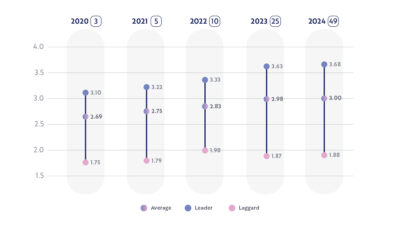
Digital transformation is often framed as a race—faster, broader, more. More technology. More use cases. More initiatives.
But for many organizations, this “more is better” mindset becomes the very thing that slows them down.
They’re not moving fast.
They’re spinning in circles.
Why? Because they’re trying to do too much—without knowing what actually matters most.
The truth is, lack of prioritization is one of the top reasons digital transformations stall. Projects compete for resources. Teams pull in different directions. And strategy becomes a wish list instead of a roadmap.
It doesn’t have to be this way.
Let’s explore how one global consumer goods company shifted from scattered execution to focused acceleration—and the business results that followed.
Case Study: Too Much of Everything, Not Enough of the Right Things
The company had everything on paper:
- A digital transformation office
- AI use cases in development
- ERP modernization underway
- A branded internal innovation program
- Over 40 initiatives across 7 functions
But they had little to show for it.
The CDO admitted, “We’re busy—but are we effective?”
The COO said, “We have too many good ideas, and no filter.”
The CFO, more bluntly: “Where’s the ROI?”
Their leadership team was fatigued. Middle managers were confused. Business units were skeptical.
That’s when they turned to us—not for another roadmap, but for clarity.
Seeing the Full Picture
We facilitated a full Digital Maturity Index (DMI) assessment, bringing together 22 senior leaders from marketing, sales, supply chain, finance, IT, HR, and product.
Over one day, we walked them through a moderated, evidence-based evaluation of their maturity across six dimensions. The exercise forced them to step back—not into the weeds, but into the why.
The resulting score—3.1 out of 5—was respectable. But what it revealed was far more important:
- Strong foundations in technology and operations
- Weaknesses in strategic alignment and change management
- Major redundancy across initiatives, especially in analytics, customer experience, and automation
More than 15 initiatives were unknowingly overlapping in scope. Three separate teams were building customer data platforms. Five automation pilots were operating in isolation. A new AI pricing engine was being ignored because the commercial teams didn’t trust the input data.
One Platform, One Truth
Within 72 hours, the leadership team was onboarded to our Strategy Cockpit—where the full assessment, benchmarks, recommendations, and initiative list were structured and visualized.
We asked one simple question:
“If you could only do five things this year—what would they be?”
That forced a mindset shift.
They moved from defending turf to building focus.
From “projects” to “outcomes.”
From silos to synergy.
The Strategy Cockpit helped them:
- Cluster 40+ initiatives into 12 strategic themes
- Prioritize based on business value and feasibility
- Eliminate or postpone 14 projects—freeing up $2.3M in budget and over 22,000 FTE hours
- Reallocate resources toward five cross-functional programs with high impact potential
Those five included:
- A unified customer intelligence platform
- End-to-end supply chain digitization
- Commercial pricing optimization powered by AI
- Workforce digital capability development
- Agile product innovation cycles for high-growth markets
Too Many Initiatives, Not Enough Impact?
Choosing the right digital initiatives is what turns strategy into results. Learn how our Digital Transformation solution helps you prioritize with clarity, align stakeholders, and drive measurable outcomes.
The Business Results
Within nine months, the results were clear—and impressive.
- Supply chain digitization reduced lead times by 11%, saving over $1.4M in logistics costs
- Pricing optimization delivered a 2.1% increase in average order margin across two product categories, adding $2.7M in net revenue
- Improved customer insights enabled more targeted campaigns, increasing conversion rates by 16%
- Internal stakeholder satisfaction with the digital program rose by 38% in quarterly surveys
- And perhaps most importantly, leaders finally felt in control.
One SVP put it simply:
“We’re not chasing digital anymore—we’re steering it.”
Why Prioritization Works
Prioritization is more than a project management tactic.
It’s a strategic discipline.
Here’s why it delivers outsized value:
1. It aligns the organization.
When everyone sees the same list of top priorities, they make better decisions. Resource conflicts drop. Dependencies are identified early. Governance becomes simpler.
2. It protects attention.
Executives and teams can focus their energy. This improves quality, accelerates delivery, and prevents burnout.
3. It accelerates ROI.
By focusing on the highest-impact initiatives, organizations see results faster—creating momentum and increasing buy-in.
4. It builds trust.
When stakeholders see projects moving and delivering value, their confidence in the transformation grows.
And all of this starts by having the courage to choose—and to say no.
Measurement as the Catalyst
Of course, prioritization doesn’t happen in a vacuum.
You need structure. You need data. You need perspective.
The maturity assessment gave this company a mirror.
Benchmarking showed them how they compared to peers.
The Strategy Cockpit gave them a command center to steer from.
Most importantly, the assessment session brought leaders together. They listened. They aligned. They chose.
And because they chose together, they executed together.
A Repeatable Discipline
Three months after prioritizing, the company created a formal quarterly transformation forum. The purpose: to revisit priorities, track progress, and manage resource allocation in real time.
They no longer needed a consultant to do this—they had built the capability internally.
That’s the real outcome of structured measurement and prioritization: not just better decisions, but better decision-making habits.
The Cost of Not Prioritizing
Let’s not forget the alternative.
Without prioritization:
- Good projects die in competition with great ones
- Resources are spread thin and deliver less
- Leaders argue instead of align
- Transformation feels chaotic, reactive, and slow
The consumer goods company was on that path. They reversed it by stepping back, measuring, and choosing what mattered most.
The result wasn’t just a cleaner portfolio.
It was a clearer future.
What’s Measured Gets Done
This story reinforces a core truth:
Transformation is not about doing more. It’s about doing what matters.
- Measurement helps you understand where you are.
- Prioritization helps you choose where to go.
- Benchmarking helps you validate those choices.
- And platforms like the Strategy Cockpit help you stay on track.
When you combine those elements, transformation stops being an aspiration—and becomes a business capability.
In a world of too much digital noise, clarity is the ultimate competitive advantage.




